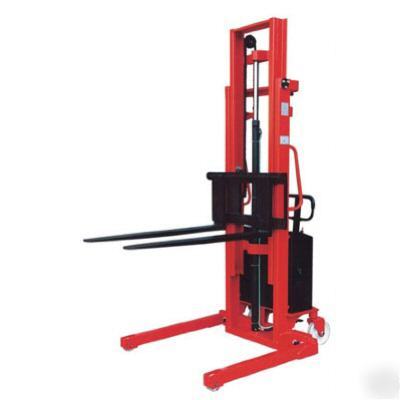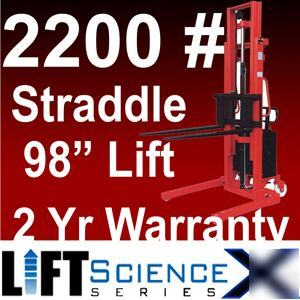Quiet Electronics Moderated Newsgroup For The Electronic Professionals and Other Professionals > Maine
> New pallet stackers straddle walkie forklift forklifts
New pallet stackers straddle walkie forklift forklifts
Pallet Stackers Straddle Walkie Forklift Forklifts New
Adjustable width. 36"L x 6"W x 3"H. 48.5" between straddle legs
pallet stacker, charger, battery, and operating manual
Required; $125 additional charge
Usually in stock; otherwise 2-4 weeks
$100 extra charge for residential or liftgate delivery
Pallet Stacker, Electric Forklift, Lift Truck Selection Guide:
The average empty pallet weighs approximately 50 pounds. Some weigh in at more than 80 pounds. Choosing an efficient method of gathering and managing pallets can mean the difference between profit and loss-employee safety and hazardous working conditions. And what about full pallets? If not moved properly, you risk product damage and steep drops in quality. When it comes to efficient storage and distribution, the pallet stacker you choose is critical. Its use will save time and money and also prevent needless injuries.
Lift Height and Weight Capacity
* You'll want to choose the pallet stacker lift truck that fits in best with your routine and warehouse set-up. The most basic questions are: How high do you need to lift and how much weight capacity?
* Pallet stackers will typically lift up to a maximum of 12 feet or lower and can handle up to 3300 lbs. More than this and you should probably consider a full blown forklift.
Manual Drive or Electric Drive?
* Electric drive pallet stackers will be more expensive to purchase and operate than manual drive models but are better suited to high duty use, use in parking lots, and where the warehouse employees can't muscle the weight around. These models will all feature forward/reverse variable speeds and safety brakes.
* Forkover design is where the forks of the pallet lift truck lower right on top of the stabilization legs. The advantages of this design are that it is less expensive, takes up less space and can maneuver in tight aisles. The disadvantage is since the forks are directly over the stabilization legs, you cannot pick up a closed bottom pallet directly from the floor; however, this is still an excellent choice for unloading trucks and this disadvantage can be overcome with either open bottom pallets/skids or blocks.
* Counterweight or counterbalance stackers offer some benefits of both of the previously mentioned styles but with some other drawbacks. Counterweight stackers can lift pallets direclt off of the floor since there are no stabilization legs to get in the way. The disadvantages are that the weight capacity and lift height will typically be less than the other styles.
Self-propelled stackers are similar to forklift trucks but not as large or as expensive usually. Yet, you can take a stacker to the loading dock, pick up a loaded pallet of merchandise, travel with it back to the retail store side of the operation, position your stacker unit at the shelf up to twelve feet in the air and smoothly lift the pallet and merchandise to the level of the storage shelf and remove the forks from the pallet, leaving the merchandise and pallet safely positioned on a shelf.
Self-propelled stackers are usually constructed of steel with the wheels of polyurethane. The controls for raising and lowering the forks, forward and reverse speeds and the brake are generally located in the handle on the heavy duty models or as a separate lever for raising and lowering the forks on the medium duty units.
The unit is steered with the aid of a butterfly handle which tilts and twists as well as lowering or raising as required. A double safety braking system is available on the self-propelled stackers. Not only does the dead man’s feature prevent riderless runaway vehicles, but the unit ensures protection from dropping carriage, forks or mast.
The mast is the upright portion of the stacker on which the carriage rides that does the actual work of raising or lowering the forks. The mast also serves as protection for the operator from loads falling backward onto the stacker.
The stabilization legs and the forks may be adjustable for different pallet sizes or support needs. Stabilization legs may be straddle type, fork over or in some instances there will be no stabilization legs, being replaced by a counterweight sytem.
Although the self-propelled stackers are not capable of a high rate of speed—most have a top speed of around 5 miles per hour—they can still travel fast enough to create some safety hazards. Pushing the top limits of speed, especially with the load extended can create top-heavy conditions and may lead to longer stopping times in an emergency stop situations. Although visibility is excellent on the empty stackers, when loaded they have almost no front visibility. Particularly in high traffic areas, care must be taken to avoid running into or over other employees.
Other common safety issues with equipment of this type is running over feet.
* We do not offer local pickup for any pallet stackers, forklifts, electric forklifts, forklift extensions, or electric pallet jacks.
* Personal / Company Checks (All checks will be held for 7 days)
You can contact us by emailing ****@forkliftdeals.com or by phone at (***) 246-6096.



